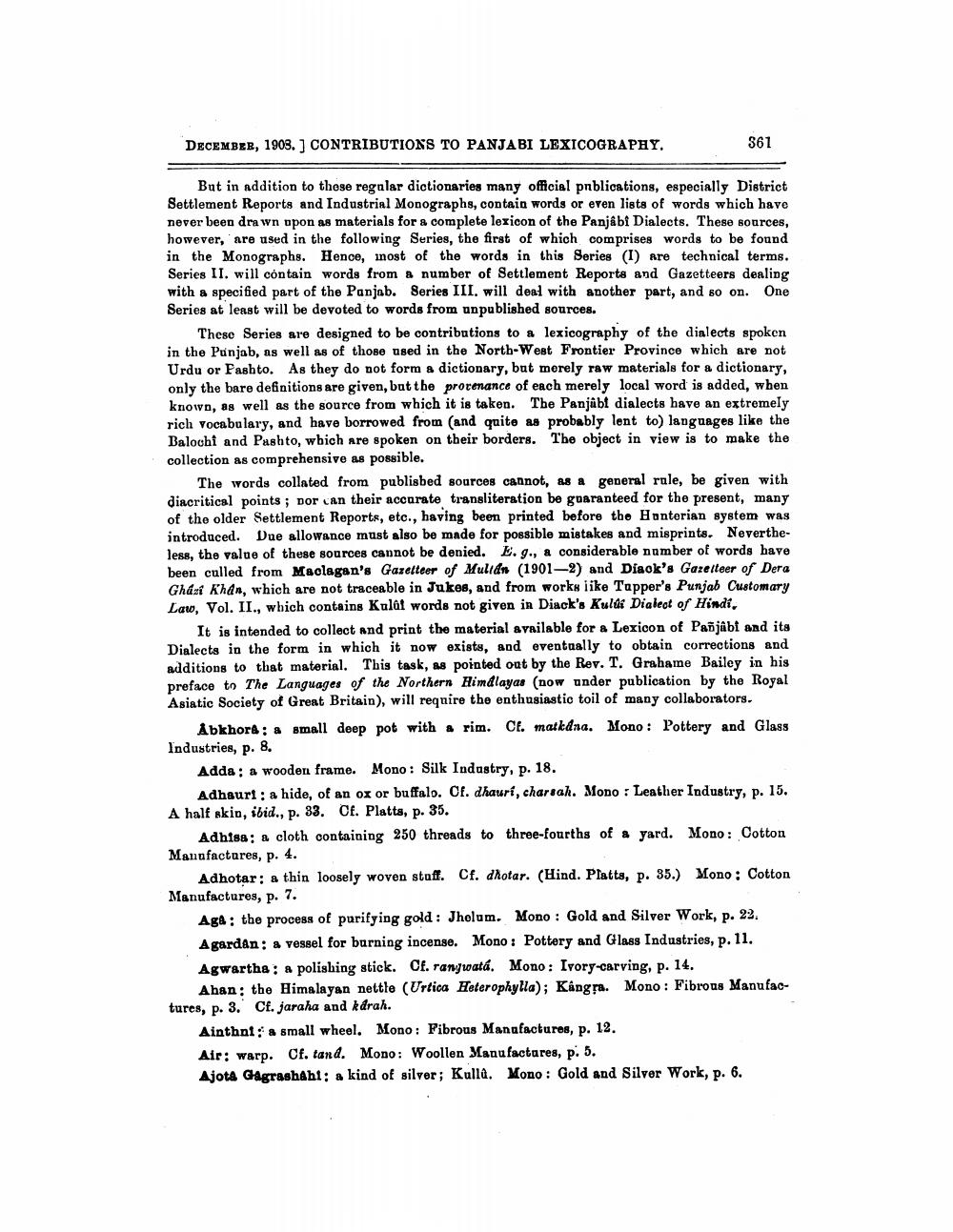________________
DECEMBER, 1903. ] CONTRIBUTIONS TO PANJABI LEXICOGRAPHY.
But in addition to these regular dictionaries many official publications, especially District Settlement Reports and Industrial Monographs, contain words or even lists of words which have never been drawn upon as materials for a complete lexicon of the Panjabi Dialects. These sources, however, are used in the following Series, the first of which comprises words to be found in the Monographs. Hence, most of the words in this Series (I) are technical terms. Series II. will contain words from a number of Settlement Reports and Gazetteers dealing with a specified part of the Panjab. Series III. will deal with another part, and so on. One Series at least will be devoted to words from unpublished sources.
361
These Series are designed to be contributions to a lexicography of the dialects spoken in the Punjab, as well as of those used in the North-West Frontier Province which are not Urdu or Fashto. As they do not form a dictionary, but merely raw materials for a dictionary, only the bare definitions are given, but the provenance of each merely local word is added, when known, as well as the source from which it is taken. The Panjabi dialects have an extremely rich vocabulary, and have borrowed from (and quite as probably lent to) languages like the Balochi and Pashto, which are spoken on their borders. The object in view is to make the collection as comprehensive as possible.
The words collated from published sources cannot, as a general rule, be given with diacritical points; nor can their accurate transliteration be guaranteed for the present, many of the older Settlement Reports, etc., having been printed before the Hunterian system was introduced. Due allowance must also be made for possible mistakes and misprints. Nevertheless, the value of these sources cannot be denied. E. g., a considerable number of words have been culled from Maclagan's Gazetteer of Multan (1901-2) and Diack's Gazetteer of Dera Ghazi Khan, which are not traceable in Jukes, and from works iike Tapper's Punjab Customary Law, Vol. II., which contains Kulût words not given in Diack's Kului Dialect of Hindi,
It is intended to collect and print the material available for a Lexicon of Panjabi and its Dialects in the form in which it now exists, and eventually to obtain corrections and additions to that material. This task, as pointed out by the Rev. T. Grahame Bailey in his preface to The Languages of the Northern Himalayas (now under publication by the Royal Asiatic Society of Great Britain), will require the enthusiastic toil of many collaborators.
Abkhora: a small deep pot with a rim. Cf. matkana. Mono: Pottery and Glass Industries, p. 8.
Adda; a wooden frame. Mono: Silk Industry, p. 18.
Adhauri: a hide, of an ox or buffalo. Cf. dhauri, charsah. Mono: Leather Industry, p. 15. A half skin, ibid., p. 33. Cf. Platts, p. 35.
Adhisa: a cloth containing 250 threads to three-fourths of a yard. Mono: Cotton Manufactures, p. 4.
Adhotar: a thin loosely woven stuff. Cf. dhotar. (Hind. Platts, p. 35.) Mono: Cotton Manufactures, p. 7.
Aga: the process of purifying gold: Jhelum. Mono: Gold and Silver Work, p. 22. Agardan: a vessel for burning incense. Mono: Pottery and Glass Industries, p. 11. Agwartha: a polishing stick. Cf. rangwatá. Mono: Ivory-carving, p. 14.
Ahan the Himalayan nettle (Urtica Heterophylla); Kângra. Mono: Fibrous Manufactures, p. 3. Cf. jaraha and karah.
Ainthni: a small wheel. Mono: Fibrous Manufactures, p. 12.
Air: warp. Cf. tand. Mono: Woollen Manufactures, p. 5.
Ajota Gagrashahi: a kind of silver; Kullu. Mono: Gold and Silver Work, p. 6.




